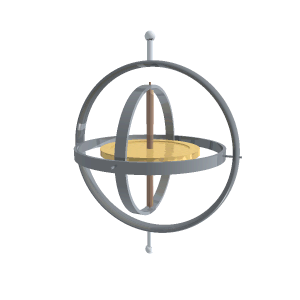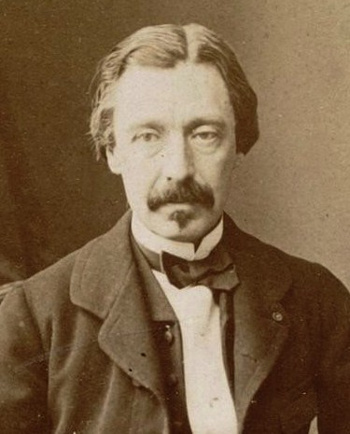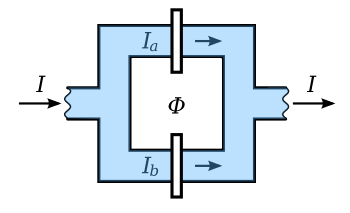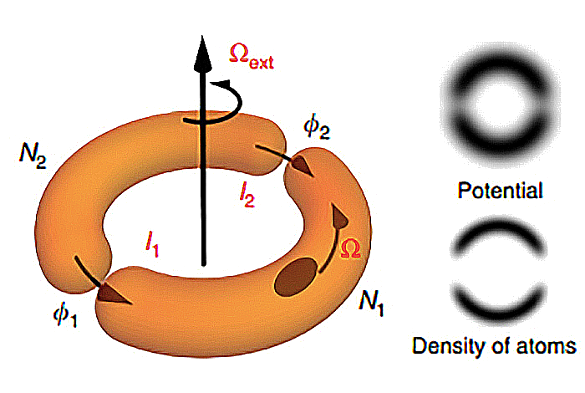Going in Circles
August 31, 2020
Circles and circular
motion are ubiquitous in
nature, so they are also ubiquitous in
physics. One of my
uncles embraced this concept when he would explain to people that his
nephew did "
pi-r-squared physics." The
Greek philosophers considered the circle to be the most perfect of shapes, so it's no wonder that
astronomy embraced
Ptolemy's model of the Solar System and its circular
orbits, including the circular
epicycles, for many
centuries.
Motion in a circle and the principle of
angular momentum can be found in the
gyroscope.
Toy gyroscopes are easy to
manufacture, so they are a part of many a
child's extracurricular education, including my own. Gyroscopes are fascinating, since their
spin axis will stay pointed in the direction of their initial spin-up if not perturbed by an external
force. This principle was important in the early days of
navigation, and my former
employer, an
aerospace giant, manufactured a variety of
mechanical gyroscopes for
inertial navigation. Spinning
mass gyroscopes have been displaced by
ring laser gyros and
fiberoptic gyroscopes, and a variety of
MEMs devices.

A gyroscope maintaining its direction when held in a frame of three gimbals.
This gyroscope is held in place by jewel bearings at each end. While these offer low friction, energy loss through friction at the bearings and with air will cause the gyroscope to slow and eventually stop.
electrostatic suspension in some gyroscopes mitigates such frictional energy losses by suspending a ball in a vacuum using electric fields created by electrodes, generally an octant of electrodes, around the sphere.[1] An orthogonal trio of motor windings is used to bring the ball up to speed and orient it in a desired direction. A circumferential air jet is sometimes used for the initial spin-up.
(Wikimedia Commons image by Lucas Vieira.)
So, why does a gyroscope maintain its direction? As I discovered as a
student in
high school physics
class, the "why" answers that are usually accepted are not all that satisfying. An early question in the venerable
PSSC physics textbook (I remember it's being question one in chapter one) asked why
light bends when it enters
water. The expected "answer" was
Snell's law. The real answer is that the
speed of light is slower in water; so, light, in
taking the the path which takes the least time, makes the bend into water. This
phenomenon, called
Fermat's least time principle, is a special case of the more general
least action principle.
The accepted answer of why a gyroscope maintains its direction is
conservation of angular momentum. Angular momentum will only be conserved if the rotating gyroscope maintains its direction. However, the origin of angular momentum is a
mystery.[2] As stated in the
tagline to the article in ref. 2, "...we still don't know how a gyroscope stays pointed in a fixed direction."[2]
The gyroscope was given its name by
Foucault, who used one in an 1852
experiment to demonstrate the
Earth's rotation, much like his eponymous
Foucault pendulum of 1851. Friction forces allowed gyroscopic action for just a few minutes, but the time was sufficient for a measurement. Foucault named the device a gyroscope from the
Greek γῦρος (gyros, circle or rotation) and σκοπέω (skopeein, to see), as in seeing the rotation of the Earth.

An 1882 portrait of French physicist and astronomer, Léon Foucault (1819–1868).
Before his gyroscope experiment, Foucault built a massive, long period, pendulum, that had its swing fixed in direction. Just as the motion of a falling body is independent of its mass, a pendulum's period is independent of mass.
Making the pendulum massive, however, helps to overcome friction forces at its pivot. The period is a function of the square root of the length for small swing amplitude.
(Wikimedia Commons image by Zátonyi Sándor.)
Foucault would have believed that the directions of his pendulum and gyroscope were fixed with respect to
absolute space. The idea of an absolute space was proposed by
Isaac Newton (1642-1727) in his
Principia. The concept of an absolute space was challenged by physicist and
philosopher,
Ernst Mach, who is better known for his
Mach number.
Mach, in his
book, "The Science of Mechanics," proposed that instead of absolute space, that local
physical laws are determined by the large-scale
structure of the
universe.[3] In particular, the
inertia of a body arises from its
interaction with everything else in the universe. This idea is now known as
Mach's principle. In Mach's scheme, the rotation of a gyroscope is fixed with respect to the distant
stars and
galaxies.
An interesting case of rotation occurs in
superconducting loops, where
electron pairs circulate to produce a persistent
current without an applied
voltage. One important application for this is the
superconducting electromagnet, but the phenomenon is used in the
superconducting quantum interference device (SQUID), a sensitive
magnetometer based on the
Josephson effect that involves
quantum tunneling through an
insulating barrier. SQUIDs can detect extremely low
magnetic fields, of the order of a few
attotesla (a
refrigerator magnet has a field of about 10
16 attotesla).

Schematic diagram of a DC SQUID.
The applied magnetic flux Φ causes an imbalance in the circulating supercurrents in the two portions of the loop to cause a voltage to appear across the entrance and exit points of the loop.
(Modified Wikimedia Commons image by Miraceti.)
Physicists from
Los Alamos National Laboratory, Los Alamos, New Mexico, and
Miami University, Oxford, Ohio, have created an
atomtronic version of a SQUID that's sensitive to mechanical rotation.[4-5] Just like a gyroscope, this atomtronic Superconducting Quantum Interference Device has the potential for sensing ultrasensitive rotation measurements.[5] The
research team describes this device in an
open access paper in a recent issue of
Nature Communications.[4]
Says study author,
Changhyun Ryu of the Los Alamos National Laboratory,
"In a conventional SQUID, the quantum interference in electron currents can be used to make one of the most sensitive magnetic field detectors... We use neutral atoms rather than charged electrons. Instead of responding to magnetic fields, the atomtronic version of a SQUID is sensitive to mechanical rotation."[5]
The atomtronic device consists of a layer of
cold atoms created by a
laser to form a
Bose–Einstein condensate (BEC) with a second laser imprinting a
pattern of two
semicircles with Josephson junction gaps (see figure).[5] The circular pattern is about ten
micrometers in
diameter.[4-5] When the device is rotated, the number of atoms in each semicircle changes as a consequence of the phase mismatch of atomic flow caused by quantum effects. Rotation rate is measured by counting the number of atoms in each semicircle.[4-5]

Schematic diagram of the Los Alamos National Laboratory atomtronic SQUID. Clouds of atoms are trapped within each semicircle, and rotation causes them to quantum mechanically interfere to change the number of atoms in each segment. (Los Alamos National Laboratory image.)
References:
- Lloyd A Iddings, "Electrostatically suspended gyroscope signal pickoff," U.S. Patent No. 3,320,817, May 23, 1967.
- Tony Rothman, "The Forgotten Mystery of Inertia," American Scientist, vol. 105, no. 6 (November/December 2017), pp. 344ff.
- Ernst Mach, "The Science of Mechanics," Thomas J. McCormack, Trans., The Open Court Publishing Co. (Chicago: 1919), via The Internet Archive. This is a translation of the 1887 German original.
- C. Ryu, E. C. Samson, and M. G. Boshier, "Quantum interference of currents in an atomtronic SQUID," Nature Communications, vol. 11, Article No. 3338 (July 3, 2020), https://doi.org/10.1038/s41467-020-17185-6 This is an open access article with a PDF file here.
- James Riordon, "Atomtronic device could probe boundary between quantum, everyday worlds," Los Alamos National Laboratory Press Release, July 16, 2020.
Linked Keywords: Circle; motion (physics); nature; physics; uncle; nephew; area of a circle; pi-r-squared physics; Ancient Greek philosophy; Greek philosopher; astronomy; Almagest; Ptolemy's model of the Solar System; orbit; epicycle; century; centuries; angular momentum; gyroscope; toy; manufacturing; manufacture; child; extracurricular activity; education; rotation around a fixed axis; spin axis; force; navigation; employment; employer; Honeywell Aerospace; aerospace giant; mechanics; mechanical; inertial navigation; mass; ring laser gyroscope; fiberoptic gyroscope; vibrating structure gyroscope; MEMs; gimbal; jewel bearing; friction; energy; air; electrostatic; vacuum; electric field; electrode; octant (solid geometry); sphere; orthogona; stator; motor winding; circumference; circumferential; jet (fluid); air jet; Wikimedia Commons; Lucas Vieira; student; high school; classroom; class; Physical Science Study Committee; PSSC physics; textbook; light; water; Snell's law; speed of light; taking the the path which takes the least time; phenomenon; Fermat's least time principle; least action principle; conservation of angular momentum; list of unsolved problems in physics; mystery; tagline; Foucault; experiment; Earth's rotation; Foucault pendulum; Greek; portrait photography; France; French; physicist; astronomer; Léon Foucault (1819–1868); mass; massive; period; falling body; friction; force; pivot; square root; amplitude; Zátonyi Sándor; absolute space; Isaac Newton (1642-1727); Philosophiae Naturalis Principia Mathematica; Principia; philosopher; Ernst Mach; Mach number; book; physical law; structure; universe; inertia; interaction; Mach's principle; star; galaxy; superconductivity; superconducting; loop (topology); Cooper pair; electron pair; electric current; voltage; superconducting electromagnet; superconducting quantum interference device (SQUID); magnetometer; Josephson effect; quantum tunneling; insulator (electricity); insulating; tunnel junction; barrier; magnetic field; Tesla (unit); attotesla; refrigerator magnet; Miraceti; Los Alamos National Laboratory, Los Alamos, New Mexico; Miami University, Oxford, Ohio; research; open access journal; open access paper; Nature Communications; Changhyun Ryu; neutral particle; atom; electric charge; charged; cold; laser; Bose–Einstein condensate (BEC); pattern; semicircle; micrometer; diameter; schematic diagram; quantum mechanics; quantum mechanically; wave interference; interfere.